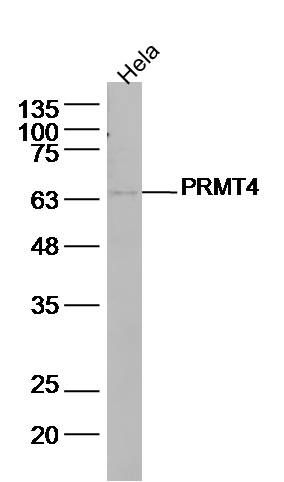产品货号 : mlR6144
英文名称 : PRMT4
中文名称 : 组蛋白精氨酸甲基转移酶CARM1抗体
别 名 : p53 induced gene 3 protein; p53-induced gene 3 protein; Putative quinone oxidoreductase; quinone oxidoreductase homolog; TP53I3; tumor protein p53 inducible protein 3; Tumor protein p53-inducible protein 3; CARM1_HUMAN.
研究领域 : 细胞生物 免疫学 信号转导 细胞凋亡 细胞周期蛋白
抗体来源 : Rabbit
克隆类型 : Polyclonal
交叉反应 : Human, Mouse, Rat, Pig, Cow, Rabbit,
产品应用 : WB=1:500-2000 ELISA=1:500-1000 IHC-P=1:400-800 IHC-F=1:400-800 IF=1:100-500 (石蜡切片需做抗原修复)
not yet tested in other applications.
optimal dilutions/concentrations should be determined by the end user.
分 子 量 : 66kDa
细胞定位 : 细胞核
性 状 : Lyophilized or Liquid
浓 度 : 1mg/ml
免 疫 原 : KLH conjugated synthetic peptide derived from human PRMT4:301-400/608
亚 型 : IgG
纯化方法 : affinity purified by Protein A
储 存 液 : 0.01M TBS(pH7.4) with 1% BSA, 0.03% Proclin300 and 50% Glycerol.
保存条件 : Store at -20 °C for one year. Avoid repeated freeze/thaw cycles. The lyophilized antibody is stable at room temperature for at least one month and for greater than a year when kept at -20°C. When reconstituted in sterile pH 7.4 0.01M PBS or diluent of antibody the antibody is stable for at least two weeks at 2-4 °C.
PubMed : PubMed
产品介绍 : The protein encoded by this gene is similar to oxidoreductases, which are enzymes involved in cellular responses to oxidative stresses and irradiation. This gene is induced by the tumor suppressor p53 and is thought to be involved in p53-mediated cell death. It contains a p53 consensus binding site in its promoter region and a downstream pentanucleotide microsatellite sequence. P53 has been shown to transcriptionally activate this gene by interacting with the downstream pentanucleotide microsatellite sequence. The microsatellite is polymorphic, with a varying number of pentanucleotide repeats directly correlated with the extent of transcriptional activation by p53. It has been suggested that the microsatellite polymorphism may be associated with differential susceptibility to cancer. At least two transcript variants encoding the same protein have been found for this gene (from EntrezGene).
Function:
Methylates (mono- and asymmetric dimethylation) the guanidino nitrogens of arginyl residues in several proteins involved in DNA packaging, transcription regulation, pre-mRNA splicing, and mRNA stability. Recruited to promoters upon gene activation together with histone acetyltransferases from EP300/P300 and p160 families, methylates histone H3 at 'Arg-17' (H3R17me), forming mainly asymmetric dimethylarginine (H3R17me2a), leading to activate transcription via chromatin remodeling. During nuclear hormone receptor activation and TCF7L2/TCF4 activation, acts synergically with EP300/P300 and either one of the p160 histone acetyltransferases NCOA1/SRC1, NCOA2/GRIP1 and NCOA3/ACTR or CTNNB1/beta-catenin to activate transcription. During myogenic transcriptional activation, acts together with NCOA3/ACTR as a coactivator for MEF2C. During monocyte inflammatory stimulation, acts together with EP300/P300 as a coactivator for NF-kappa-B. Acts as coactivator for PPARG, promotes adipocyte differentiation and the accumulation of brown fat tissue. Plays a role in the regulation of pre-mRNA alternative splicing by methylation of splicing factors. Also seems to be involved in p53/TP53 transcriptional activation. Methylates EP300/P300, both at 'Arg-2142', which may loosen its interaction with NCOA2/GRIP1, and at 'Arg-580' and 'Arg-604' in the KIX domain, which impairs its interaction with CREB and inhibits CREB-dependent transcriptional activation. Also methylates arginine residues in RNA-binding proteins PABPC1, ELAVL1 and ELAV4, which may affect their mRNA-stabilizing properties and the half-life of their target mRNAs.
Subunit:
Homodimer (Probable). Interacts with the C-terminus of NCOA2/GRIP1, NCO3/ACTR and NCOA1/SRC1. Part of a complex consisting of CARM1, EP300/P300 and NCOA2/GRIP1. Interacts with FLII, TP53, myogenic factor MEF2, EP300/P300, TRIM24, CREBBP and CTNNB1. Identified in a complex containing CARM1, TRIM24 and NCOA2/GRIP1. Interacts with NCOA3/SRC3. Interacts with SNRPC (By similarity). Interacts with NR1H4. Interacts with RELA. Interacts with HTLV-1 Tax-1.
Subcellular Location:
Nucleus. Cytoplasm. Note=Mainly nuclear during the G1, S and G2 phases of the cell cycle. Cytoplasmic during mitosis, after breakup of the nuclear membrane.
Tissue Specificity:
Overexpressed in prostate adenocarcinomas and high-grade prostatic intraepithelial neoplasia.
Post-translational modifications:
Auto-methylated on Arg-550. Methylation enhances transcription coactivator activity. Methylation is required for its role in the regulation of pre-mRNA alternative splicing (By similarity).
Phosphorylation at Ser-216 interferes with S-adenosyl-L-methionine binding and strongly reduces methyltransferase activity (By similarity). Phosphorylation at Ser-216 is strongly increased during mitosis, and decreases rapidly to a very low, basal level after entry into the G1 phase of the cell cycle. Phosphorylation at Ser-216 may promote location in the cytosol.
Similarity:
Belongs to the protein arginine N-methyltransferase family.
SWISS:
Q86X55
Gene ID:
10498
Important Note:
This product as supplied is intended for research use only, not for use in human, therapeutic or diagnostic applications.
产品图片












